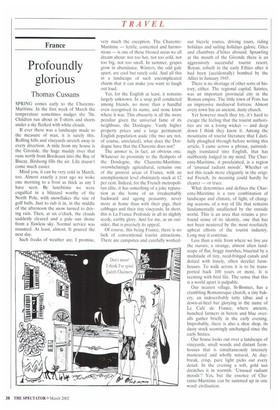Profoundly glorious
Thomas Cussans
SPRING comes early to the CharenteMaritime. In the first week of March the temperature sometimes nudges the 70s. Children run about in T-shirts and shorts under a sky flecked with white clouds.
If ever there was a landscape made to the measure of man, it is surely this. Rolling hills and vineyards stretch away in every direction. A mile from my house is the Gironde, the huge muddy river that runs north from Bordeaux into the Bay of Biscay. Birdsong fills the air. Life doesn't come much easier.
Mind you, it can be very cold in March, too. Almost exactly a year ago we woke one morning to a frost as thick as any I have seen. By lunchtime we were engulfed in a blizzard worthy of the North Pole, with snowflakes the size of golf balls. Just to rub it in, in the middle of the afternoon the snow turned to driving rain. Then, at six o'clock, the clouds suddenly cleared and a pale sun shone from a flawless sky. Normal service was resumed. At least, almost. It poured the next day.
Such freaks of weather are, I promise, very much the exception. The CharenteMaritime — fertile, contented and harmonious — is one of those blessed areas we all dream about: not too hot, not too cold, not too big, not too small. In summer, grapes grow in abundance. Winters, the odd gale apart, are cool but rarely cold. And all this in a landscape of such uncomplicated charm that it can make you want to laugh out loud.
Yet, for the English at least, it remains largely unknown. In a snap poll conducted among friends, no more than a handful even recognised its name, and none knew where it was, This obscurity is all the more peculiar given the universal fame of its neighbour, the Dordogne. Vastly higher property prices and a large permanent English population aside (the two are not, of course, unrelated), what does the Dordogne have that the Charente does not?
The answer is, in fact, an obvious one. Whatever its proximity to the fleshpots of the Dordogne, the Charente-Maritime, overwhelmingly agricultural, remains one of the poorest areas of France, with an unemployment level obstinately stuck at 12 per cent. Indeed, for the French metropolitan elite, it has something of a joke reputation as the home of an irredeemably backward and ageing peasantry, never more at home than with their pigs, their cabbages and their tiny vineyards. In short, this is La France Profonde in all its slightly seedy, earthy glory. And for me, as an outsider, that is precisely its appeal.
Of course, this being France, there is no lack of conventional tourist attractions. There are campsites and carefully worked out bicycle routes, driving tours, riding holidays and sailing holidays galore. Gites and chambres d'hotes abound. Sprawling at the mouth of the Gironde there is an aggressively successful tourist resort, Royan, rebuilt in the early Fifties after it had been (accidentally) bombed by the Allies in January 1945.
There is no shortage of other sorts of history, either. The regional capital, Saintes, was an important provincial city in the Roman empire. The little town of Pons has an impressive mediaeval fortress. Almost every town has an ancient, dusty church.
Yet however much they try, it's hard to escape the feeling that the tourist authorities are on a losing wicket — and deep down I think they know it. Among the mountains of tourist literature that I dutifully ploughed through before writing this article, I came across a phrase, painstakingly translated into English, that has stubbornly lodged in my mind. The Charente-Maritime, it proclaimed, is a region of 'unusual radiant moods'. Whether or not this reads more elegantly in the original French, its meaning could hardly be clearer — or truer.
What determines and defines the Charente-Maritime is a rare combination of landscape and climate, of light, of changing seasons, of a way of life that remains fundamentally unaffected by the outside world. This is an area that retains a profound sense of its identity, one that has not been neutered by the most resolutely upbeat efforts of the tourist industry. Long may it continue.
Less than a mile from where we live are the marais, a strange, almost alien landscape of flat, boggy marshes, bisected by a multitude of tiny, reed-fringed canals and dotted with lonely, often derelict farmhouses. To walk across it is to be transported back 100 years or more. It is teeming with bird life. The sense that this is a world apart is palpable.
Our nearest village, St-Bonnet, has a crumbling Romanesque church, a tiny bakery, an indescribably tatty tabac and a down-at-heel bar glorying in the name of Le Café de France, where ancient, hunched farmers in berets and blue overalls gather briefly in the early evening. Improbably, there is also a shoe shop, its dusty stock seemingly unchanged since the early Sixties.
Our house looks out over a landscape of vineyards, small woods and distant farmhouses that is simultaneously intensely manicured and wholly natural At daybreak, crisp, pure light picks out every detail. In the evening a soft, gold sun drenches it in warmth. 'Unusual radiant moods'? Yes, but the essence of Charante-Maritime can be summed up in one word: civilisation.














































































 Previous page
Previous page